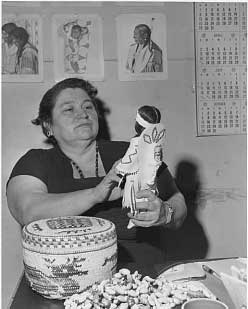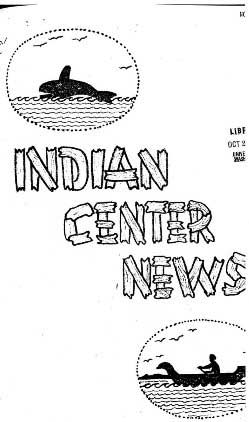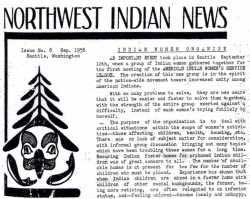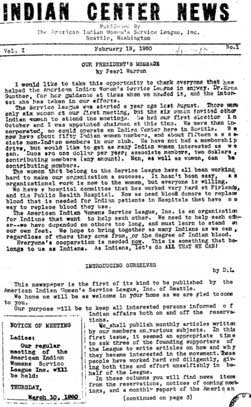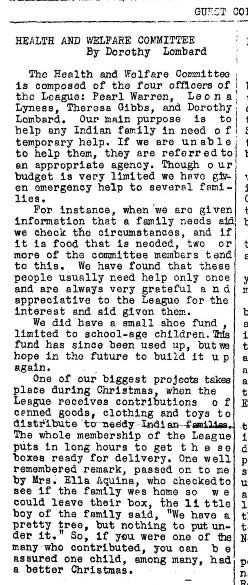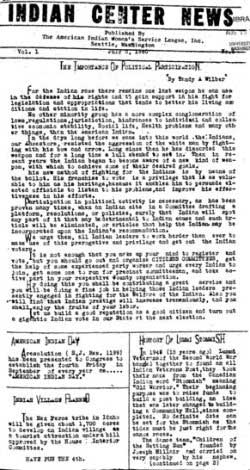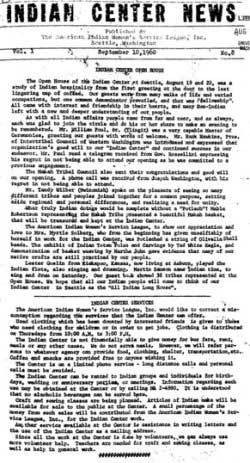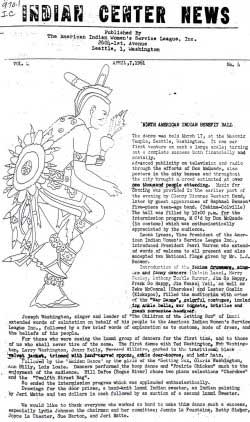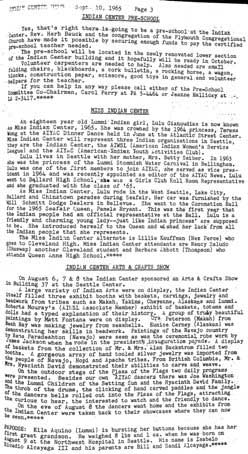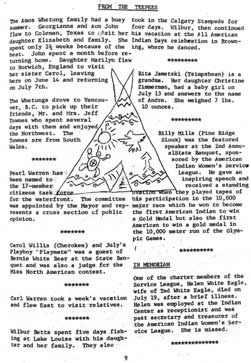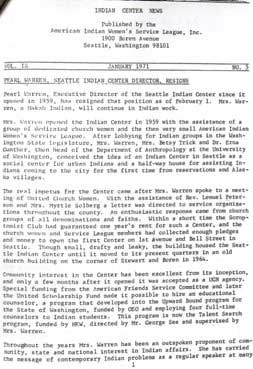In 1970, an American Indian couple that had tried unsuccessfully to find work in Alaska arrived in Seattle to continue their search. They were penniless, lived in their car with their two children, and had no food and no idea what to do. They were unaware of any services the government and other assistance agencies could offer them.1 Many American Indians who migrated from reservations to Seattle in search of work during the 20th century suffered a similar plight, living in deep poverty and enduring great difficulties adjusting to urban life. These difficulties were often due to inadequacies in healthcare and education, unemployment, and being disconnected from their communities and cultures. Also, few people outside the American Indian community knew of their plight. Non-Indians knew little about Indian culture and often harbored negative stereotypes of American Indians.
Founded in 1958 in Seattle, the American Indian Women’s Service League (AIWSL) was the first organization in Seattle dedicated towards tackling the problems of urban Indians. The stated purpose of the American Indian Women’s Service League was to “deal with critical situations within the scope of women’s activities— those affecting children, health, housing, etc.”2 However, the AIWSL went far beyond the scope of a charitable organization involving “women’s” activities. It raised public consciousness of important urban Indian issues, brought Indian cultural traditions to the city, built a sense of community among Seattle Indians, and started an expansive network of essential social service organizations dedicated to helping urban Indians. Their hard work and dedication improved the lives and image of urban American Indians in the Pacific Northwest and beyond.
A number of political and economic circumstances drove American Indians to move off the reservations and into urban settings like Seattle, in search of seasonal or full-time work. Indians had long migrated through American cities for commerce and social reasons. Puget Sound and other Northwest Indians, after first moving to reservations, were permitted to travel between reservations and outside them in search of work, making Seattle a crucial cultural and trading meeting place for indigenous people. Pacific Northwest Indians, who had relied on primarily on fishing and hunting for centuries, found it increasingly difficult to sustain themselves with these occupations alone, and found reservation resources and federal programs insufficient in helping them adapt to agricultural or other forms of work. This resulted in deep poverty and poor living conditions, often resulting in no option but to move off the reservation in search of a better life.
World War II began a great economic boom in Seattle and the demand for labor greatly increased. Many Indians in the Pacific Northwest, as well as from all regions around the country, migrated to Seattle to work in the aerospace, shipyard, and military support industries, as well as to serve in the armed forces at Seattle-area bases.3 After the war, many former Indian soldiers did not return to the reservations and instead sought work in the Seattle area. But as the economic boom slowed, jobs became scarcer. Many urban Seattle Indians were left displaced and jobless, taking up residence in Seattle’s Skid Road, a working class neighborhood around Pioneer Square that catered to transient workers.
Before the 1950s, Indians in Seattle were not formally organized. When American Indian issues received local attention, it was mostly at the behest of non-Indian churches and civic organizations. Among the volunteers were a number of middle-class American Indian women who helped less fortunate Indians on an informal basis, taking them into their homes and providing the help they needed in emergency situations. Pearl Warren, a Makah originally from Neah Bay, organized seven of these women together to form the American Indian Women’s Service League (AIWSL) in 1958. The organization quickly grew to more than 50 members by the fall of 1958, with members from throughout the Northwest and even the Plains.4
Warren and other members of the service league saw the immediate need for a place for local Indians to congregate, find a sense of community, and receive the culturally appropriate help and services they needed. Warren believed it was important to have a “hospitality center” for Indians that would accomplish the following goals: “(1) be a friendly place for Indians to meet, (2) give assistance to Indians who are not acquainted with the city ways of living, (3) refer those with educational medical or other problems to proper channels for advice, (4) and very important, preserve our Indian culture.”5
Warren and the AIWSL sent letters to service organizations throughout the country, and by 1960 they had raised the funds to open the Seattle Indian Center in a small building downtown. The center expanded over the years and became a place where urban Indians could feel at home, express their culture, and improve themselves. In fact, it was the first place many Indians went to when they first arrived in Seattle (sometimes because AIWSL members waited at the bus station to welcome new arrivals).6 The Indian Center also became the launching pad for numerous social service programs and committees sponsored by AIWSL members.
Pearl Warren became the first Executive Director of the Indian Center. During her 11-year term there, she launched and expanded many of the programs and services provided by the Indian Center, particularly as federal War on Poverty funding became available. She educated the community and furthered the cause of improving the lives of urban Indians through her involvement in schools, church groups, and civic organizations, as well as through other committees such as the Seattle and Puget Sound Environmental Health Council. She was elected Assistant Secretary of the Seattle Model Cities Program, and chaired the national organization, Americans Indians United. She was the only Indian to testify about the plight of urban Indians before U.S. Sen. Robert Kennedy’s Committee on Indian Education.7
Pearl Warren and the AIWSL made public relations an important part of their goal to “make Indians part of the community they live in, and to get non-Indians to recognize us as an Indian group.”8 Indians were portrayed by the national mainstream media, as well as in Seattle community events, as figments of the past. Indians also had relatively small numbers compared to other racial and ethnic groups in Seattle, making up less than one percent of the city’s total population according to the 1960 U.S. Census. 9
The AIWSL strived to increase visibility for Seattle Indians by appearing as guest speakers and giving presentations on Indian culture to non-Indian groups. The organization also sponsored community and cultural events, such as fundraising dinners and dances featuring traditional Indian dancers from many tribes. AIWSL members publicized these events in print, radio, and television to a non-Indian audience. Due to these efforts, the first North American Indian Jamboree and Benefit Ball held by the AIWSL in 1961 attracted more than a thousand people.10 Their annual salmon bake on Alki Point became very popular, attracting more than a thousand people annually. These efforts not only raised funds for the AIWSL, but they also made Indians a visible, recognized, and celebrated part of the wider Seattle community.
To further promote public awareness of issues and events affecting American Indians in the Pacific Northwest, the AIWSL began publishing a small monthly newsletter the Indian Center News in 1960. In only five years, the _Indian Center News_’s circulation expanded to include subscribers throughout and beyond the Pacific Northwest, as well as government officials, public institutions such as universities and libraries, and other Indian organizations.11 The editorial staff was comprised of AIWSL and Indian Center volunteers, who wrote and compiled much of the newsletter’s content. In 1971, the paper started being published as the Northwest Indian News in an expanded newsprint format, reaching more than 2,600 subscribers.
The Indian Center News and _Northwest Indian News_promoted a sense of community among the diverse, geographically dispersed Indian population of the Pacific Northwest. Unlike other groups in Seattle categorized by race or ethnicity, Seattle Indians were dispersed throughout the city. They also varied widely with respect to economic class, ranging from homeless to working class to middle-class, and came from many tribes in the Northwest as well as from around the country. These publications reached out to all Indians and the Pacific Northwest, transcending tribal, geographic, and economic lines, and provided a means of communication between the cities and the reservations. A monthly events calendar kept the community up to date and encouraged all Indians to come together and become involved in organizational and committee meetings, cultural events, and youth activities. The papers even urged readers to contribute articles, giving all Indians an opportunity to voice their concerns.
To further build a sense of community among Pacific Northwest Indians, each issue of the Indian Center News featured a “From the Teepees” section (“Teepee Talk” in the Northwest Indian News), with personal news straight from the homes of local Indians. This was a forum for women in the community to announce special events, such as marriages, births, college graduations, or even day-to-day happenings, such as an older woman enjoying the company of her grandchildren. This gave an opportunity for Indian women to show a sense of pride in their personal accomplishments or those of their families and friends, and to keep in touch with each other through print. The author of this column, Ella Aquino, one of the AIWSL’s founders, eventually brought her column to the radio on the local station KRAB.12
The Indian Center News and Northwest Indian News also educated the public about important issues affecting Indians, and provided helpful information. The newspapers educated their readers about local and national government policies and current legislation affecting American Indians, and encouraged Indians to become politically involved. The Northwest Indian News published a series of articles about US history told from an American Indian perspective. Monthly columns offered advice on legal issues such as landlord-tenant law, the legal rights of arrested persons, and where to receive free or low-cost legal help. The papers also publicized programs and opportunities that helped Indians receive adequate healthcare and education. Articles and columns such as these promoted public awareness of Indian issues among Indians and non-Indians alike, and helped local Indians learn about and gain access to much-needed social services.
One of the most important causes the AIWSL championed was education. The League saw education as being most critical to the well-being and the future of American Indians, and the best way to overcome poverty. The Indian Center News and Northwest Indian News repeatedly reported widespread educational problems, though it seemed to focus its attention on the social uplift of Indian students rather than the politics of developing a culturally appropriate and relevant education in Seattle’s schools. The papers discussed issues such as absenteeism and late enrollment, which led to high school dropout rates of 18 to 21.8 percent among Indian students in the 1960’s.13 Educational difficulties were also due to a living environment in some Indian communities which involved deep poverty, alcoholism, overcrowding, and lack of parental involvement. Many Indian families could not teach their children the types of skills and discipline necessary to succeed in public schools. They also did not understand the necessity and importance of high school and possibly postsecondary education in securing a future for their children.14
The AIWSL recognized the importance of these educational challenges and made it a priority to help Indian students succeed in school. During the 1960s, an AIWSL education committee started a study hall program at the Indian Center, where volunteer tutors assisted many Indian students of all ages with their homework. The AIWSL also started the Indian Center preschool so that young Indian children could get a head start on reading, listening, group cooperation, and other important skills needed to succeed in the public school system.15 The Indian Center also provided educational and career counseling. It provided a successful GED class each year to help Indians receive their high school diploma. The AIWSL’s dedication to educational programs resulted in a higher quality education and increased opportunities for many young Indians throughout the Pacific Northwest.
Another problem that plagued the Seattle Indian community was unemployment, which was at 45 percent among American Indians nationally in 1965.16 Many Indians lacked the education and skills to be successful in the workplace. To help Indians beyond high school and into their careers, several members of the AIWSL, along with other professional Indians in the community, formed the American Indian Professional Association (AIPA). Their members were successful in fields such as electrical engineering, interior design, law, and dentistry. Their goal was “to help Individual Indians make a place for themselves in the Business World.”17
To help Indians become successful in the workforce, the AIPA promoted and stressed the importance of education and job-training among young Indians, and created and spread awareness of scholarship opportunities. They looked for job opportunities geared toward American Indians, and emphasized the field of Indian arts and crafts that allowed them to express their cultures and creativity. Lydia Johnson, a Nez Perce and Cayuse, explained the reasoning behind these programs when she wrote that “…it is ridiculous to expect in Indian to be content…with an assembly-line job so different from the individualistic creativity Indians are familiar with.”18 The AIPA helped many Indians receive the education and training they needed, and instilled in their community a sense of pride and a desire to become successful in the workforce.
Another way in which the AIWSL increased job opportunities for Indians was by turning its own volunteers into paid employees. Warren was able to parlay her organization’s success and community recognition toward increased fundraising which allowed her and some of her core volunteers to finally receive paid employment through the Center. And as their programs expanded, other staff, such as the education counselors and preschool teachers, were hired and paid for their services as well. This provided a new means for local Indian women to enter the workforce, as many female Indian Center employees had significant leadership experience, but no previous employment experience outside the home. These entry-level positions served as a “training ground” in the expanding social services field, paving the way for advancement to more prestigious positions in other organizations.19
Another problem that heavily concerned the AIWSL and the Indian Center was the poor health conditions suffered by urban Indians. Most Indians had no health insurance, and suffered disproportionately high rates of debilitating diseases such as tuberculosis, diabetes, and hepatitis20. The AIWSL began addressing this health crisis by starting a referral service for Indians that could help prevent, diagnose, and treat disease. The work of their health-related committees led to the formation of the Seattle Indian Health Board (SIHB), which still exists today. In 1970, the SIHB established a free clinic at the Seattle Public Health Hospital staffed by volunteer physicians, providing a variety of services including pediatric care, family planning, and even dentistry. Demonstrating both the demand for the services as well as the diversity of Seattle’s Indian population, the free clinic served over 1,100 patients from more than 100 tribes throughout the United States and Canada during its first 16 months of operation,.21
Throughout the run of Northwest Indian News, alcoholism was a recurring theme and cause for concern in American Indian family life. In 1973, the Northwest Indian News claimed that an estimated one out of four Seattle Indians was an alcoholic.22 The imprisonment of Indians due to alcohol- and drug-related crimes further tore apart families and the community. In 1961, League members and Indian Center volunteers established an Indian Center Alcoholics Anonymous group to combat this problem. Later, the SIHB established the more formalized Seattle Indian Alcoholism Program at the Indian Center. This program was staffed by Indians who were recovering alcoholics and counselors, and provided further supports and treatment for alcoholics in the Indian community. The Northwest Indian News also featured a monthly “Facts About Alcoholism” column to provide information about alcoholism-related resources and education for the Seattle Indian community.
Though the League itself was more social service oriented than protest oriented, it also nurtured a burgeoning sense of Indian activism that outgrew the organization itself. Indian Center volunteer Bernie Whitebear of the Colville tribe organized an occupation of Fort Lawton in an attempt to seize the land in 1970 on behalf of all of Seattle’s urban Indians. More than a hundred Indians took part in this demonstration. While the AIWSL did not participate directly, many of its members supported this movement from behind the scenes, bringing the demonstrators food and drink when needed, and publicizing the cause in the Indian Center News.23 This demonstration led to the founding of a new political and social service organization to promote the cause of urban Indians that many AIWSL members also took part in: the United Indians of All Tribes Foundation (UIATF). Several years later, the UIATF built the Daybreak Star Center at Discovery Park, a cultural facility for urban Indians.
The AIWSL also believed strongly in preserving and exposing others to traditional American Indian culture through the arts. In her columns in Indian Center News and Northwest Indian News, AIWSL member Maxine Cushing Gray encouraged the Seattle Indian community to “do-it-yourself in the arts,”24 pointing out that “Indian” art and souvenirs sold locally were often inauthentic and manufactured in other countries, and Indian dances at Seattle events such as Seafair were performed by non-Indians. The Indian Center began sponsoring arts and crafts shows in the Seattle Center featuring baskets, totems, dolls, jewelry, and paintings by Indian artists (including some AIWSL members) from the Northwest and Alaska. The League founded its own Indian arts and crafts store in the Indian Center, now called Traditions and Beyond. The AIWSL also established an Indian cultural presence in Seattle at community events by sponsoring Indian-led traditional dance classes and exhibitions as well as fashion shows featuring local Indian clothing designers and models.
AIWSL members also served the cultural needs of the urban Indian community, while raising funds, by publishing a cookbook. The AIWSL compiled favorite recipes of their members and friends into a book, Old and New Indian Recipes. The types of traditional recipes contained in the book illustrated Northwest Indians’ cultural traditions relating to food and their relationship to their surrounding environment. The great number and variety of seafood, wild meat, and poultry recipes indicated that Northwest Indian tribes primarily hunted, gathered, and fished for their food, and were not agricultural in nature. This was an example of how threatening and taking away hunting and fishing rights, and forcing Indians onto agricultural reservation lands, was a threat to their traditional way of life. Old and New Indian Recipes was the AIWSL’s way of helping to preserve and share these culinary cultural traditions among Indians and non-Indians alike, as well as to raise awareness of the importance of hunting and fishing to their culture.
Also among the pages of _Old and New Indian Recipes_were helpful hints for daily life. One section contains tips for preparing traditional American Indian foods with modern kitchen appliances and tools. Suggestions for maintaining an efficient modern household included techniques for laundry and cleaning. This recipe book, and the recipes and advice it contained, preserved American Indian cultural traditions while furthering the service league’s goal of helping Indian households transition to a modern urban lifestyle.
In 1970, the AIWSL also kept Indian cultural traditions alive in modern cities by sponsoring Indian Legends, a 34-page collection of traditional Indian stories contributed by Indians from fifteen North American tribes. Indian Legends featured tales of various adventures of people and animals, many of which taught a “moral” or lesson important to the Indians’ system of values. Several stories were about the origins of traditional Indian crafts, such as basketry and bread-making. A federal grant from the National Endowment for the Humanities made it possible to purchase 250 copies of the Indian Legends and distribute them to schools, colleges, libraries, and other public institutions.25 Indian Legends served as an important means of passing on cultural traditions to Indian children, as well as an educational tool for non-Indian teachers and students nationwide.
Over the years, the American Indian Women’s Service League made a positive difference in the lives of thousands of American Indians, easing their transition to urban life and helping them become successful. The AIWSL helped several generations of American Indian children succeed in school and beyond, improved access and quality of healthcare, and provided a means for American Indians to express and celebrate their culture. Due to the efforts of the AIWSL and the Indian Center, the penniless family living out of its car was able to find a two-bedroom apartment, financial assistance, clothing, and job training.26 This is one of many success stories attributed to the AIWSL and the many spin-off organizations it started.
What began as a small organization of seven Indian women continued to expand and branch out over the years; in 2002, the AIWSL’s Seattle Indian Center, the SIHB, and the UIATF together employed over 250 people and had an annual budget of over $8 million.27 Due to decades of hard work and dedication and the lasting legacy of the American Indian Women’s Service League, any American Indian in Seattle will continue be able to find, according to Collville tribe and AIWSL members Harvey Davis and Nellie M. Davis:
Food if he was hungry.
A friend if he was friendless.
Shoes if he was barefoot.
Sympathy and advice if he was troubled.
Thrown out if he was drunk.
Returned to his people if he was lost.
A quiet place to sit and read or contemplate.
Free clothing on Thursdays.
An opportunity to help our less fortunate tribesmen. 28
Copyright © Karen Smith 2006
HSTAA 353 Spring 2005
Bibliography
American Indian Women’s Service League. Indian Legends. Seattle, 1970.
American Indian Women’s Service League. Old and New Indian Recipes. Kansas City: North American Press, c. 1960
Andrews, Mildred Tanner. Woman’s Place: A Guide to Seattle and King County History. Seattle: Gemil Press, 1994.
Friday, Iris N. “Making the Invisible Visible.” Native Americas 19, no. 1 (2002): 48
Hansen, Karen Tranberg. “American Indians and Work in Seattle: Associations, Ethnicity, and Class.” PhD diss. , University of Washington, 1979.
Indian Center News. Seattle, 1960-1971
“Indian Giver.” Seattle. April 1967, 15-17.
Northwest Indian News. Seattle, 1957-1961
Northwest Indian News. Seattle, 1971-1980
Thrush, Coll. “The Crossing Over Place: Urban and Indian Histories in Seattle.” PhD diss., University of Washington, 2002.
Related Internet Resources:
The Seattle Indian Health Board (SIHB):
The United Indians of All Tribes Foundation (UIATF):
1 Lowell Halvorson , “Does the Indian Center Work? A Case History,”Indian Center News, September 1970.
2“Indian Women Organize,” Northwest Indian News, September 1958.
3 Karen Tranberg Hansen, “American Indians and Work in Seattle: Associations, Ethnicity, and Class,” (PhD diss. , University of Washington, 1979), 33-34, 64-65
4 Coll Thrush, “The Crossing Over Place: Urban and Indian Histories in Seattle,” (PhD diss., University of Washington, 2002), 307.
5 Myrtle Solberg, “Purpose of Center,” Indian Center News, February 19, 1960.
6 Coll Thrush, “The Crossing Over Place: Urban and Indian Histories in Seattle,” (PhD diss., University of Washington, 2002), 310
7 “Pearl Warren, Indian Center Director, Resigns,” Indian Center News, January 1971.
8 “Indian Giver,” Seattle, April 1967, 17.
9 Karen Tranberg Hansen, “American Indians and Work in Seattle: Associations, Ethnicity, and Class,” (PhD diss. , University of Washington, 1979), 61.
10 “North American Indian Benefit Ball,” Indian Center News, April 7, 1961.
11 Pearl Warren, “Pearl’s Message,” Indian Center News, February 19, 1965.
12 Mildred Tanner Andrews, Woman’s Place: A Guide to Seattle and King County History, (Seattle: Gemil Press, 1994), 188
13 “Educational Conference,” Indian Center News, March 8, 1965.
14 “Educational Workshop,” Indian Center News, February 21, 1962.
15 “Last Year was a Good Year,” Indian Center News, January 5, 1966.
16 “Informing Our Fellow Citizens,” Indian Center News, November 2, 1965.
17 Wilbur Betts, “Aims of the American Indian Professional Associates,”Indian Center News, October 13, 1961.
18 Lydia Johnson, “A Plea,” Indian Center News, April 6, 1961.
19 Karen Tranberg Hansen, “American Indians and Work in Seattle: Associations, Ethnicity, and Class,” (PhD diss. , University of Washington, 1979), 231
20 Karen Tranberg Hansen, “American Indians and Work in Seattle: Associations, Ethnicity, and Class,” (PhD diss. , University of Washington, 1979), 17.
21 Charley Johnston and Bernie Whitebear, “Kinechtapi Indian Clinic Newsletter,” Northwest Indian News, June 1971.
22 Ernie Turner, “Facts about Alcoholism,” Northwest Indian News, June 1973.
23 Coll Thrush, “The Crossing Over Place: Urban and Indian Histories in Seattle,” (PhD diss., University of Washington, 2002), 317.
“United Indians of All Tribes Use Invasion of Fort Lawton in Effort to Get Support For All-Indian Multi-service and Educational Center,” Indian Center News, April 1970.
24 Maxine Cushing Gray, “Do It Yourself in the Arts,” Indian Center News, April 7, 1960.
25 Maxine Cushing Gray, “NEH Project Ends with Positive Accomplishments in Law and Education,” Indian Center News, October 1970.
26 Lowell Halvorson, “Does the Indian Center Work? A Case History,” Indian Center News, September 1970.
27 Iris N. Friday. “Making the Invisible Visible,” Native Americas 19, no. 1 (2002): 48.
28 Harvey Davis and Nellie M. Davis, “Letters to the Editor,” Indian Center News, March 1971.


